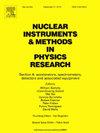基于人工神经网络的中子和伽马成像探测器命中位置重建算法
IF 1.4
3区 物理与天体物理
Q3 INSTRUMENTS & INSTRUMENTATION
Nuclear Instruments & Methods in Physics Research Section A-accelerators Spectrometers Detectors and Associated Equipment
Pub Date : 2025-07-08
DOI:10.1016/j.nima.2025.170841
引用次数: 0
摘要
中子和伽马成像在核安全、国家安全、材料表征等方面的应用不断扩大。命中位置重建算法是制约图像保真度和精度的关键问题。本工作开发了一个基于单片锂玻璃闪烁体和硅光电倍增管阵列的二维平面中子和伽马成像系统。从位置非线性响应、洪水图像均匀性和有用视场三个指标的结果表明,所提出的人工神经网络(ANN)方法明显优于传统的重建方法。“720”和“SCU”模型的成像结果证实了人工神经网络方法的优越重建质量。此外,人工神经网络方法对“T”模型实现了约0.47 mm的系统中子成像空间分辨率。这些算法在实验成像系统中实现,尽管存在一定的噪声伪影,但人工神经网络方法保持了可接受的图像质量,证实了其在模拟和实验环境中的适用性。这项工作表明,人工神经网络方法显著提高了定位精度和计算效率,从而获得了优异的中子/伽马成像质量。本文章由计算机程序翻译,如有差异,请以英文原文为准。
The hit position reconstruction algorithm for neutron and gamma imaging detectors based on artificial neural networks
Neutron and gamma imaging have continuously expanded applications in nuclear safety, national security, and materials characterization. The hit position reconstruction algorithm is a key issue that constrains the image fidelity and accuracy. This work has developed a two-dimensional planar neutron and gamma imaging system based on a monolithic lithium glass scintillator and a silicon photomultiplier array. The results from the three metrics position nonlinearity response, flood image uniformity, and useful Field-Of-View demonstrate that the proposed artificial neural network (ANN) method significantly advances over traditional reconstruction methods. Imaging results from both the ‘720’ and ‘SCU’ models confirm the ANN method's superior reconstruction quality. In addition, the ANN method achieves a systematic neutron imaging spatial resolution of approximately 0.47 mm for the ‘T’ model. These algorithms are implemented in experimental imaging system, the ANN method maintains acceptable image quality although certain noise artifacts are found, confirming its applicability in both simulated and experimental settings. This work demonstrates that the ANN method significantly enhances positioning accuracy and computational efficiency, resulting in superior neutron/gamma imaging quality.
求助全文
通过发布文献求助,成功后即可免费获取论文全文。
去求助
来源期刊
CiteScore
3.20
自引率
21.40%
发文量
787
审稿时长
1 months
期刊介绍:
Section A of Nuclear Instruments and Methods in Physics Research publishes papers on design, manufacturing and performance of scientific instruments with an emphasis on large scale facilities. This includes the development of particle accelerators, ion sources, beam transport systems and target arrangements as well as the use of secondary phenomena such as synchrotron radiation and free electron lasers. It also includes all types of instrumentation for the detection and spectrometry of radiations from high energy processes and nuclear decays, as well as instrumentation for experiments at nuclear reactors. Specialized electronics for nuclear and other types of spectrometry as well as computerization of measurements and control systems in this area also find their place in the A section.
Theoretical as well as experimental papers are accepted.

 求助内容:
求助内容: 应助结果提醒方式:
应助结果提醒方式:


